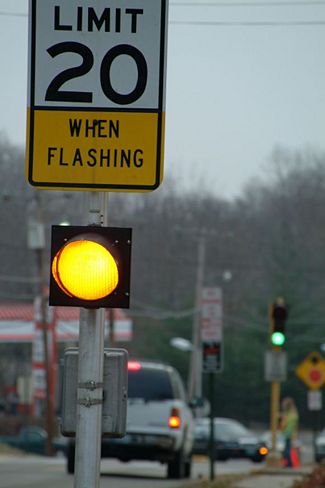Category:908 Traffic Controls for School Areas
Contents
- 1 908.1 Need for Standards (MUTCD Section 7A.01)
- 2 908.2 School Routes and Established School Crossings (MUTCD Section 7A.02)
- 3 908.3 School Crossing Control Criteria (MUTCD Section 7A.03)
- 4 908.4 Scope (MUTCD Section 7A.04)
- 5 908.5 School Signs (MUTCD Section 7B)
- 6 908.6 School Markings (MUTCD Section 7C)
- 7 908.7 Crossing Supervision (MUTCD Section 7D)
- 8 908.8 School Speed Limits
- 9 908.9 Flashers and Signals for School Zones
908.1 Need for Standards (MUTCD Section 7A.01)
Support. Regardless of the school location, the best way to achieve reasonably safe and effective traffic control is through the uniform application of realistic policies, practices and standards developed through engineering judgment.
Pedestrian safety depends upon public understanding of accepted methods for efficient traffic control. This principle is especially important in the control of pedestrians, bicycles, and other vehicles in the vicinity of schools. Neither pedestrians on their way to or from school nor road users can be expected to move safely in school areas unless they understand both the need for traffic controls and how these controls function for their benefit.
Procedures and devices that are not uniform might cause confusion among pedestrians and road users, prompt wrong decisions, and contribute to crashes. To achieve uniformity of traffic control in school areas, comparable traffic situations need to be treated in a consistent manner. Each traffic control device and control method described in Traffic Controls for School Areas fulfills a specific function related to specific traffic conditions.
A uniform approach to school area traffic controls assures the use of similar controls for similar situations (which promotes uniform behavior on the part of motorists, pedestrians and bicyclists).
A school traffic control plan permits the orderly review of school area traffic control needs and the coordination of school/pedestrian safety education and engineering activities.
Guidance. The type(s) of school area traffic control devices used, either warning or regulatory, should be related to the volume and speed of vehicular traffic, street width and the number and age of the students.
908.2 School Routes and Established School Crossings (MUTCD Section 7A.02)
Support. To establish a safer route to and from school for schoolchildren, the application of planning criterion for school walk routes might make it necessary for children to walk an indirect route to an established school crossing located where there is existing traffic control and to avoid the use of a direct crossing where there is no existing traffic control.
Guidance. School walk routes should be planned to take advantage of existing traffic controls. The availability of adequate sidewalks to and from the location with existing traffic control, the number of students using the crossing, the age levels of the students and the total extra walking distance should all be considered in determining the feasibility of requiring children to walk to a crossing location with existing traffic control.
908.3 School Crossing Control Criteria (MUTCD Section 7A.03)
Support. Not applicable to MoDOT.
908.4 Scope (MUTCD Section 7A.04)
Standard. This article sets forth basic principles and prescribes standards that shall be followed in the design, application, installation and maintenance of all traffic control devices (including signs, signals and markings) and other controls (including adult crossing guards, student patrols and grade-separated crossings) required for the special pedestrian conditions in school areas.
Option. In-roadway signs for school traffic control areas may be used consistent with the requirements of EPG 903.5.7, EPG 903.19.8 School Sign (S1-1) and Plaques and EPG 903.19.9 School Zone Sign (S1-1) and Plaques (S4-3P) and END SCHOOL ZONE Sign (S5-2).
Support. Requirements discussed in EPG 903.1 Highway Signing General Information and EPG 903.5.4 STOP Sign (R1-1) and ALL WAY Plaque (R1-3P) are applicable in school areas.
Refer to EPG 900.1 General (MUTCD CHAPTER 1A) for additional information about the purpose of traffic control devices, principles of traffic control devices, maintenance of traffic control devices, authority for placement of traffic control devices and engineering study and engineering judgment, respectively.
908.5 School Signs (MUTCD Section 7B)
See EPG 903.19 Signing for School Areas.
908.6 School Markings (MUTCD Section 7C)
See EPG 620.2.16 Stop and Yield Lines, EPG 620.2.18 Crosswalk Markings and EPG 620.2.20 Pavement Word, Symbol and Arrow Markings.
908.7 Crossing Supervision (MUTCD Section 7D)
Standard. Law enforcement officers performing school crossing supervision and adult crossing guards shall wear high-visibility retroreflective safety apparel labeled as ANSI 107-2004 standard performance for Class 2 as described in Section 6E.02 of MUTCD.
Standard. A competent adult crossing guard acting for the school district shall supervise the operation of the crosswalk and the crossing of the students during hours of operation (further qualifications are described in Section 7D.03 of the MUTCD). A school-crossing contract providing for an adult crossing guard shall be required before a marked and signed school crossing is established.
Support. The school-crossing contract can be found on the Chief Counsel’s Office Intranet site. The district engineer is authorized to sign all contracts for signs at school crossings.
Standard. Adult crossing guards shall not direct traffic in the usual law enforcement regulatory sense. In the control of traffic, they shall pick opportunity times to create a sufficient gap in the traffic flow. At these times, they shall stand in the roadway to indicate that pedestrians are about to use or are using the crosswalk, and that all vehicular traffic must stop.
Adult crossing guards shall use a STOP paddle. The STOP paddle shall be the primary hand-signaling device.
The STOP (R1-1) paddle shall be an octagonal shape. The background of the STOP face shall be red with at least 6-inch series upper-case white letters and border. The paddle shall be at least 18 inches in size and have the word message STOP on both sides. The paddle shall be retroreflectorized or illuminated when used during hours of darkness.
Standard. If flashing lights are used on the STOP paddle, the flash rate shall be at least 50, but no more than 60, flash periods per minute.
908.8 School Speed Limits
Upon receipt of a school speed limit request, the district shall perform a speed study and site investigation. The school speed limit shall be 10 mph below either the posted speed limit or the 85th percentile speed, whichever is higher, as determined by the speed study. In no case will a school speed limit of less than 25 mph be allowed.
908.9 Flashers and Signals for School Zones
See EPG 902.11 Traffic Control for Schools and EPG 902.12 Flashing Beacons for information.

